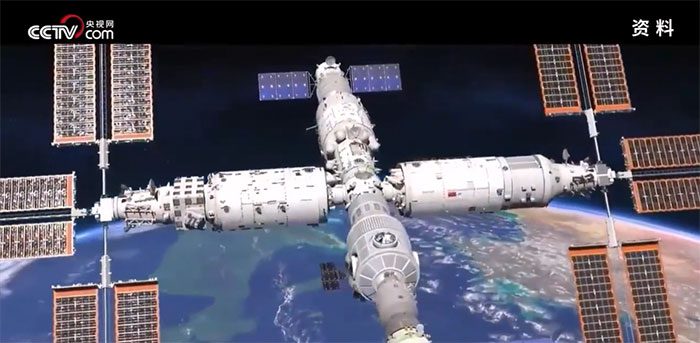The Tiangong space station will be expanded with an additional module featuring multiple docking ports for spacecraft, moving away from its current T-shaped structure consisting of three modules.
(Video: CNSpaceFlight)
China plans to expand the Tiangong space station by launching a new module that will connect to the existing T-shaped structure, creating a cross-shaped configuration, reported CGTN on March 1. China completed the T-shaped main structure of the Tiangong station in November last year, consisting of three modules. The station weighs approximately 66 tons, a small fraction compared to the International Space Station (ISS), which weighs 465 tons.
According to the China Manned Space Agency (CMSA), the new module will function as a hub cabin and will be equipped with several docking ports similar to the Tianhe core module, allowing the space station to dock with more spacecraft.
CMSA added that China intends to enhance the Tiangong station’s operations in orbit through upgrades. The station will shift its focus from technological breakthroughs during the construction phase to improving the performance of space applications.
At the Tiangong station, a series of experiments are either underway or set to begin. Some aim to discover methods to combat microorganisms that may damage metals on spacecraft, produce oxygen from algae in space, and convert thermal energy into electricity.
The astronauts of the Shenzhou 15 mission (currently living and working on the Tiangong station) have obtained 3D images of skin cells using a two-photon microscope developed by China. This microscope is the first of its kind in the world.

Simulation of the expanded Chinese space station.
In the coming years, over 65 projects will be implemented at the space station. This effort aims to enhance key technologies in preparing special materials, regenerative medicine and stem cells, high-precision time-frequency systems, and accurate quantum measurements, according to CMSA.
The Chinese Space Survey Telescope, also known as the Chinese Space Station Telescope (CSST), is set to launch and become part of the space station project. During normal observations, the telescope will operate independently of the Tiangong station but on the same orbit.
The CSST is an optical space observatory that assists astronomers in conducting sky surveys, mapping, and imaging. It can dock with the space station for refueling, scheduled maintenance, or when necessary, which allows CSST to have lower maintenance costs compared to NASA’s Hubble Space Telescope.
CMSA stated that this leading Chinese telescope is expected to survey an area of 17,500 square degrees over 10 years of operation, helping to explore significant scientific issues such as the accelerating expansion of the universe, dark matter, and dark energy.




















































